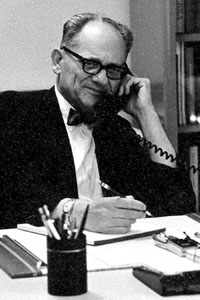Rich intellectual adventures of ‘A Cubed’ published
By Steve KoppesNews Office
 A.A. Albert earned his nickname A Cubed in 1922 from classmates in his mathematics classes at the University. | |
He almost sounds like a secret agent. Known in some circles simply as A Cubed (A³), A.A. Albert conducted classified cryptology research for the U.S. government and trotted the globe visiting exotic locations, from Buenos Aires to Moscow. Even the 10-paragraph obituary that appeared in the New York Times on June 8, 1972, barely hinted at the rich intellectual adventures in the world of numbers that Albert experienced during his lifetime.
But now his daughter, Nancy Albert (A.B.,’64, J.D.,’71), has published a biography that explores her father’s life in detail. A³ & His Algebra chronicles Abraham Adrian Albert’s rise from the Maxwell Street ghetto on Chicago’s West Side to become the E.H. Moore Distinguished Service Professor in Mathematics at Chicago and a major force in American mathematics. The book was published earlier this year by iUniverse and is available in the University Bookstore.
Nancy Albert’s inspiration was Sylvia Nasar’s book A Beautiful Mind, which tells the story of John Nash, the U.S. mathematician who shared the 1994 Nobel Prize in Economic Sciences.
“I noticed that her biography centered around MIT, Princeton, Harvard and other eastern establishment schools,” she said. “I became curious to know whether the University of Chicago might have some interesting stories that hadn’t been brought to light.”
The stories that emerged pertained not only to A.A. Albert, but also to the tradition-rich history of the University Mathematics Department itself.
A.A. Albert was the first son of a Russian immigrant couple and the only member of his immediate family to attend college. After he arrived on the University campus in 1922 as a 16-year-old first-year student, his mathematics classmates quickly nicknamed him A Cubed.
Nancy Albert said her father mostly “lived, ate, drank and slept mathematics” as an undergraduate. “Although math majors were required to take at least nine classes in math, he took 20 of them during his undergraduate years.”
Albert earned his S.B. in 1926, and remained at Chicago for graduate studies, becoming a doctoral student of Leonard Dickson. But Albert also took five graduate-level courses from Eliakim Moore, the mathematician who founded Chicago’s Mathematics Department. In fact, Dickson was the first student to receive a Ph.D. from the department in 1896, and joined its faculty in 1900. Today, the department’s Dickson instructorships are named in his honor.
Dickson, along with two other faculty members whom Moore had hired earlier—Oskar Bolza and Heinrich Maschke—quickly led the department into the nation’s upper echelons.
“In his first five years at Chicago, Dickson had managed to discover an algebra that was destined to spark a revolution,” Nancy Albert said. “Dickson’s algebra, which later became known as the ‘cyclic algebra,’ would become the cornerstone for great leaps of progress in understanding algebra.”
Albert completed his Ph.D. in 1928, and then taught at Columbia University before returning to Chicago as an Assistant Professor in 1931. Still in his 20s, he took a one-year appointment in 1933 at the newly opened Institute for Advanced Study in Princeton, N.J., which would soon become the intellectual home of Albert Einstein. In fact, it was A.A. Albert and his wife who met Einstein and his wife at the train station upon the latter’s arrival.
While at the institute, three scientists approached Albert for help in developing a mathematical framework for the new science of quantum mechanics, which explains the behavior of atoms and subatomic particles. The three scientists—John von Neumann, Eugene Wigner and Pascual Jordan—all made major contributions to quantum mechanics and other fields. Wigner went on to receive the Nobel Prize in physics in 1963.
The new algebra that Albert offered as a solution turned out to be inadequate for their purposes. In 1950, however, Albert modified his algebra of quantum mechanics, and it took on new life. His discovery spurred further work by other mathematicians and eventually became known as Albert algebras.
All told, Albert published seven books on algebra from 1937 to 1968. As a dissertation adviser, he supervised the research of 30 mathematics Ph.D. students. As a leader in the mathematical community, he had been influenced by the bleak job prospects encountered by many of his mathematical friends and acquaintances.
“He became determined to search out funding sources and to broaden the job market in mathematics,” Nancy Albert said.
In parallel to mathematics he also forged a career as an administrator, both as Chairman of the Mathematics Department from 1958 to 1961, and as Dean of the Physical Sciences Division from 1962 to 1971.
As Dean, he led the effort to bring the first computers to campus. As a result, the University formed the Committee on Information Sciences, which functioned as an academic unit within the division from 1965 to 1974.
When Albert died in 1972, his friend Izaak Wirszup, Professor Emeritus in Mathematics and the College, called him “a giant of the mind and a giant of the heart.”
![[Chronicle]](/images/sidebar_header_oct06.gif)